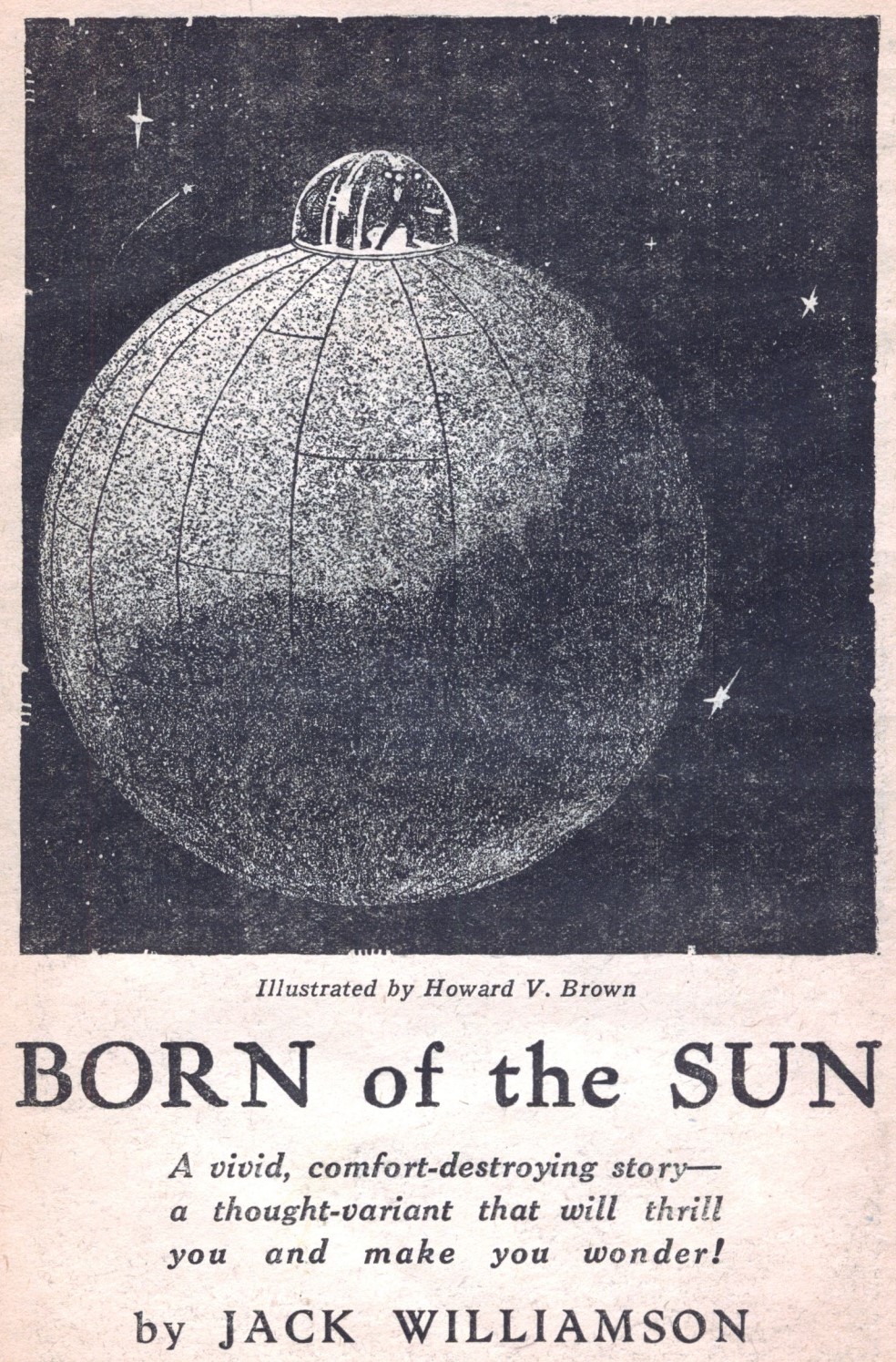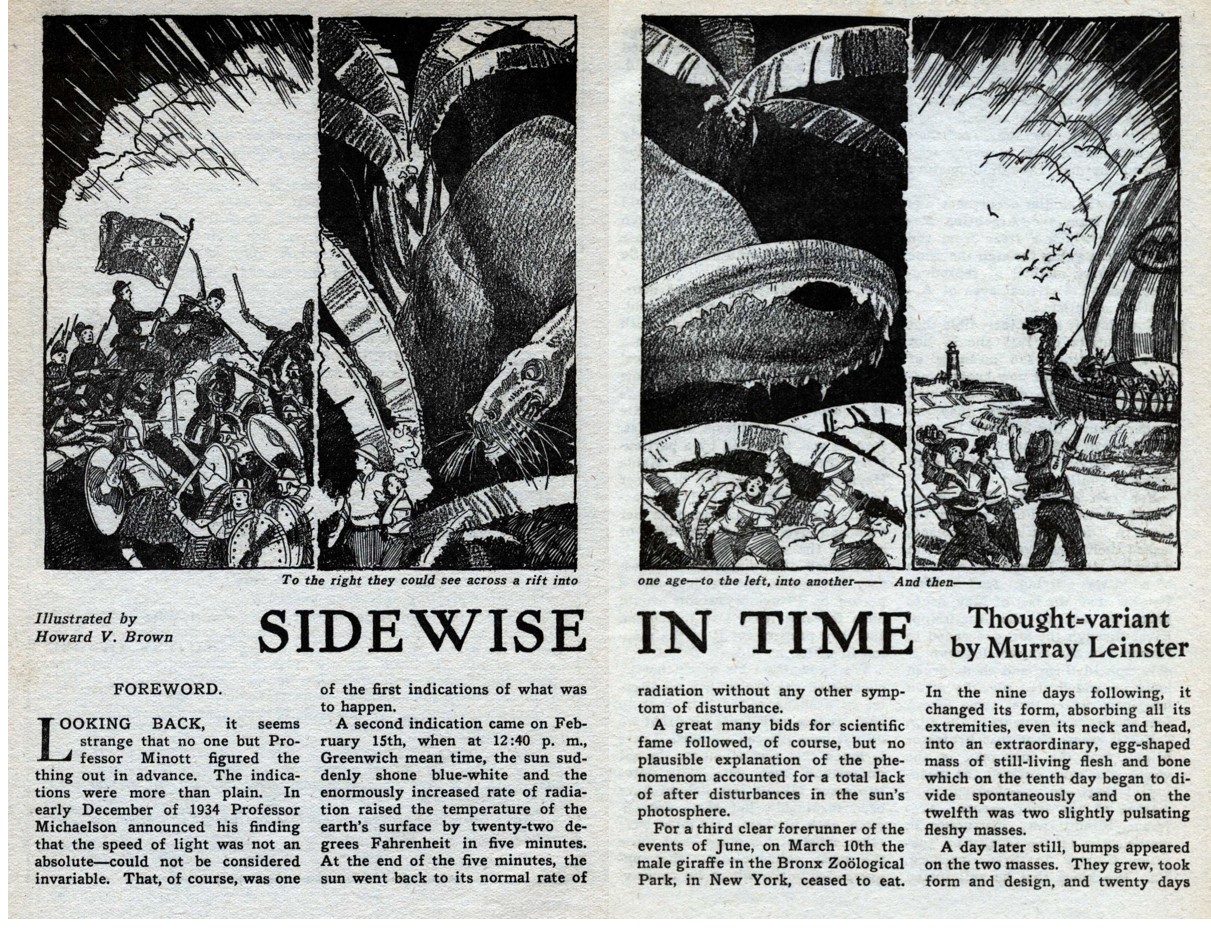


Astounding Stories - December 1933 & January 1934
In the early 1930's Astounding Stories was edited by Harry Bates and then F. Orlin Tremaine, and the generally accepted wisdom is that they published a pre-'golden age' magazine of space adventure, that lacked the ideas and thought that would characterise John W. Campbell's editorial impact on the magazines from 1939 onwards. However, once F. Orlin Tremaine took over from Bates in late 1933, he also took steps to advance SF writing and introduce more variety into the stories. At the end of 1933, Tremaine started to publish 'Feature Stories', which he also referred to as Thought-Variant stories.
The idea behind 'thought-variant' stories was to publish works that would each develop an idea that "has been slurred over or passed by in many, many stories". The aim was to shift the focus of the magazine slowly away from action-adventure and space-opera (a pejorative term at the time) and more toward ideas-based speculation - a clear preface to the advances undertaken later by John W. Campbell.
The first of these 'thought variant' stories Tremaine published was Ancestral Voices by Nat Schachner (Dec '33), and the second was Collosus by Donald Wandrei (Jan '34). Tremaine would go on and publish these 'thought-variant' stories for the remainder of his tenure as editor. I thought it would be interesting to read these two issues back-to-back, especially as there is a two-part story by Charles Willlard Diffin published across the two issues.
December 1933
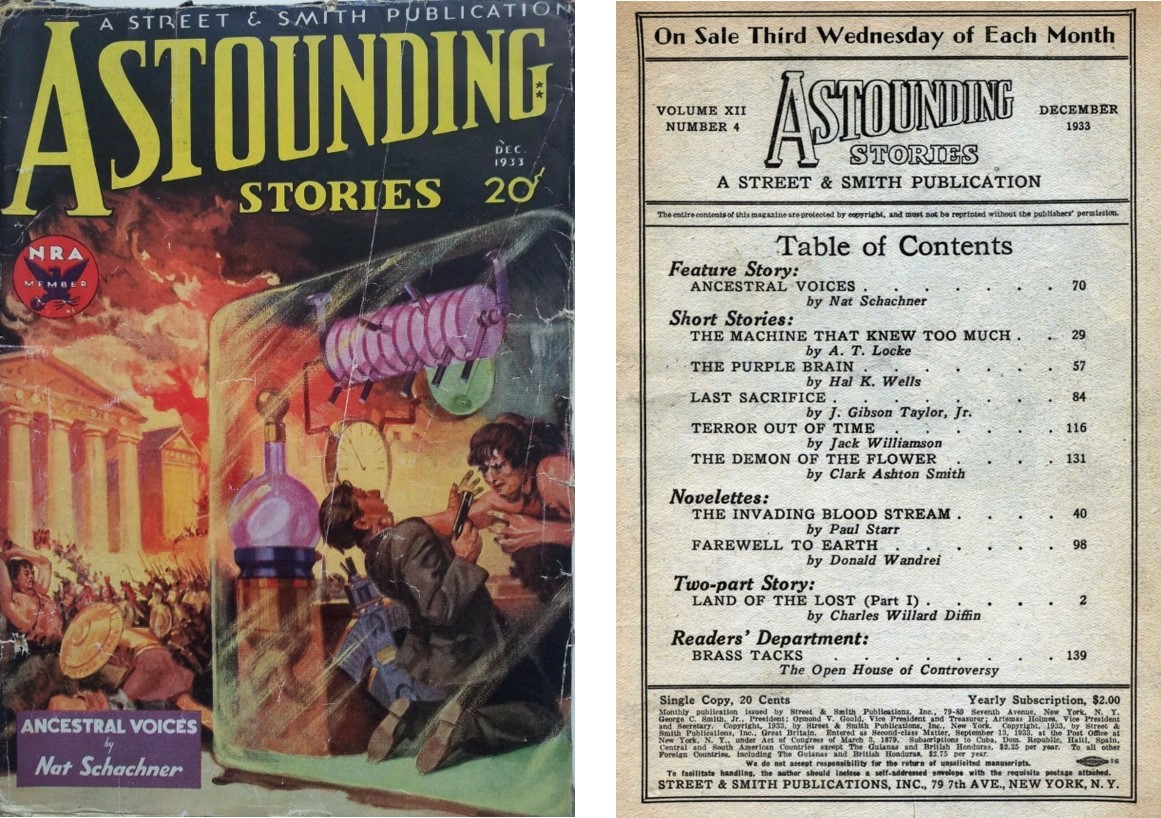
Before getting into the stories, an interesting addition to the covers of Astounding during 1933, and seen here, was the logo indicating 'NRA Member'. This has nothing to do with guns, but refers to The National Recovery Administration, set up by President Franklin D. Roosevelt in '33 as part of his 'New Deal', with the aim to encourage industries to get together and write "codes of fair competition."
Land of the Lost - Charles Willard Diffin
Diffin's two-part serial story starts in this issue and was concluded in the following Jan '34 issue. It offers unrelenting adventure, in a plot that's a bit daft, and yet is moderately compelling. This is a 'transportation to another world'-type tale and the first installment is a fun and entertaining read, with quite nice characterisation. I went ahead and read the second part of this serial from the next issue, and found the story, now set on the 'world' surrounding Earth, got sillier in the second part, though it did offer explanation of the set up. The essential idea of another world encircling our own, but with a different set of physical laws and 'neo-atoms' seems quite original. It became less based on character as it went on though and more on hyperbolic drama as the novella progressed. Ray-guns! Daring-do! Giants and pterodactyls! Ultimately it was a bit so-so, with its constant action and unwillingness to draw breath.
The Machine that Knew Too Much - A. T. Locke
This short story was a nice change of pace from Difford's action-packed, serialised novella. An old man in a creepy New England house has a machine that can hear the voices of the past. He employs a young linguist to help him listen in to ancient conversations for clues to the whereabouts of lost historical treasures. It's a nice idea, and the story is well told, with a satisfying conclusion. Locke only ever published 2 SF stories - this one and another in Astounding in 1930 (the third ever issue) - which seems a shame as this was great.
The Invading Blood Stream - Paul Starr
This novelette was the only SF story Starr ever had published. It's quite inventive and fun, as it happens, and like the Locke story, also better then the Diffin serial. A scientist affiliated with the evil Central European Confederacy has invented a method of atomic miniaturisation, and conceives a plan to miniaturise hundreds of thousands of CEC troops and inject them into the blood stream of a few unfortunate hosts, who can then be smuggled into the USA and once there, be brought back to size for invasion. While there are plot holes, and daft coincidences upon which the plot relies, it's nonetheless a neat idea for the time and was rather fun.
The Purple Brain - Hal K. Wells
Harold Wells (1899-1979) wrote twenty or so SF short stories, almost all before the 'golden age'. This is an alien monster story, in which the alien being from the planet Zaas exists as a large, purple parasitic brain. Yes, it is as pulpy as it sounds, and would have made an amusing B-movie monster flick - perhaps it did. There is little if any literary merit to this short story, though it's harmless enough entertainment if you're in the mood for such things.
Ancestral Voices - Nat Schachner(Thought-variant feature story)
And so we come to the first thought-variant feature story F. Orlin Tremaine published in Astounding. Nat Schachner was a prolific author who featured heavily in Astounding between May 1931 and November 1941 (57 stories), and who was one of Isaac Asimov's favourite authors, in his youth. This is a time travel tale, and may be one of the first to look at causality of changing the past. It's also by some margin the most literary and interesting story in this issue so far. Schachner writes well, and there's some depth and humanity here. Schachner quotes Edward Fitzgerald's 1859 translation of the poem The Rubáiyát of Omar Khayyam, refers ironically to the state of the world and prevailing xenophobia and uses an engaging prose structure to spin his yarn. At its heart, the 'thought-variant' here is to challenge the myth of 'racial purity' and in so doing celebrate the mixed heritage we all doubtless share. If Tremaine had a mind to raise the quality of the magazine with the introduction of thought-variant feature stories, he succeeded significantly at the first attempt. The story was illustrated on the cover (illustration by Howard V. Brown, see above)
The Last Sacrifice - J. Gibson Taylor, Jr
This is another story that represents the entire published SF output of the author. I'm not sure that's a bad thing, in this case. This is a fantasy tale - a ghost story really. Set in Haiti, a white immigrant man wakes and becomes invested with the ghost of a Haitian general, who leads a sacrificial voodoo ceremony. The man feels impelled to 'black-up' for the act to look more like the dead general, and kills a young innocent girl. It's not very appealing!
Farewell to Earth - Donald Wandrei
A sequel to Wandrei's novelette A Race Through Time (Astounding Oct '33), this novelette is set in the far future, after the protagonist time travels to the year 1,001,950. This is a dying Earth tale, not one where everything is shiny and improved. Life has been mostly obliterated by natural disaster, and little exists of the old world. The protagonist, Web, finds the descendent of his lost love in the ancient ruins of New York, but does the planet hold any future for them? It's a superior tale, with some '30's style action, but mainly its a somber piece, in which it's proposed that humans are not here forever. Wandrei writes pretty well, and along with Nat Schachner's thought-variant peice, this stands out as a quality story in the issue.
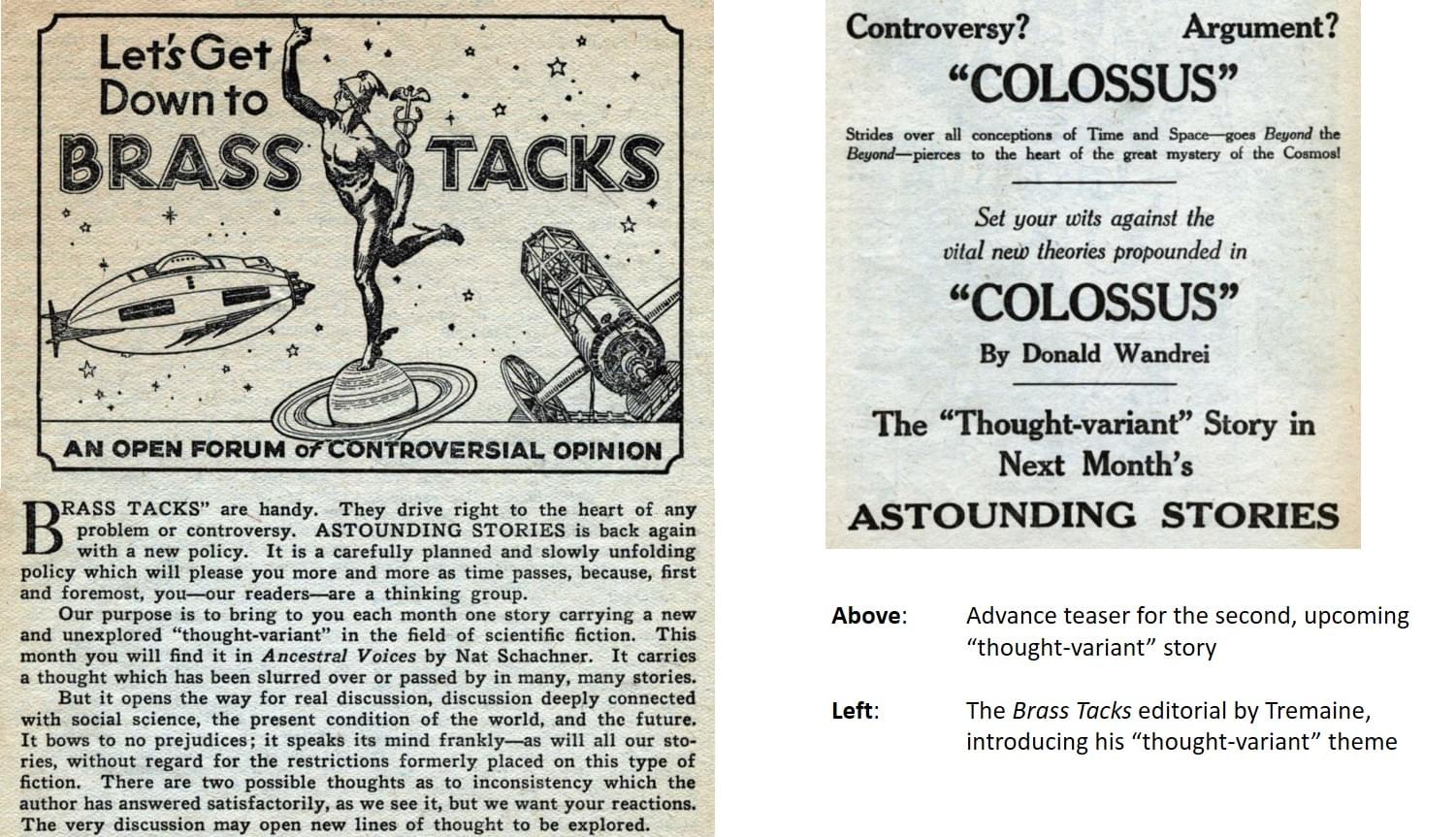
Terror out of Time - Jack Williamson
Williamson was writing frequently for Astounding at this time, and would continue to have work published in its pages for the next 6 decades. In this engaging tale a young man's mind is thrown forward in time to the end of days, though the use of a machine built by his fiancée's father. Four hundred million years in the future he inhabits the mind and body of the last human: a short white-furred pitiful creature, living under the thrall of a tall dark Martian, in a frozen, dying, world under attack from cold, gaseous beings called Ku-Latha. That's bad enough, but things don't go to plan with the experiment either, and the young man loses control and habitation of his present-day body. I'm not sure it makes complete sense, but some latitude generally has to be applied to SF stories of this era if you're to enjoy them.
The Demon of the Flower - Clark Ashton Smith
This short story, by the famed author Clark Ashton Smith, sits here in Astounding Stories as a bit of a misfit. It's written with Smith's dense, wordy, almost archaic language, heavy with other-worldly description, low on action, but steeped in evocative weirdness. If you like Smith, I'm sure it would appeal. It's a fantasy, set on another planet. A king must regularly offer a sacrifice to a demonic flower in his kingdom, but when the next victim is his betrothed he seeks a way out. It's very good, though one does have to switch gears from the pace and style of the preceding stories to enjoy it fully.
January 1934
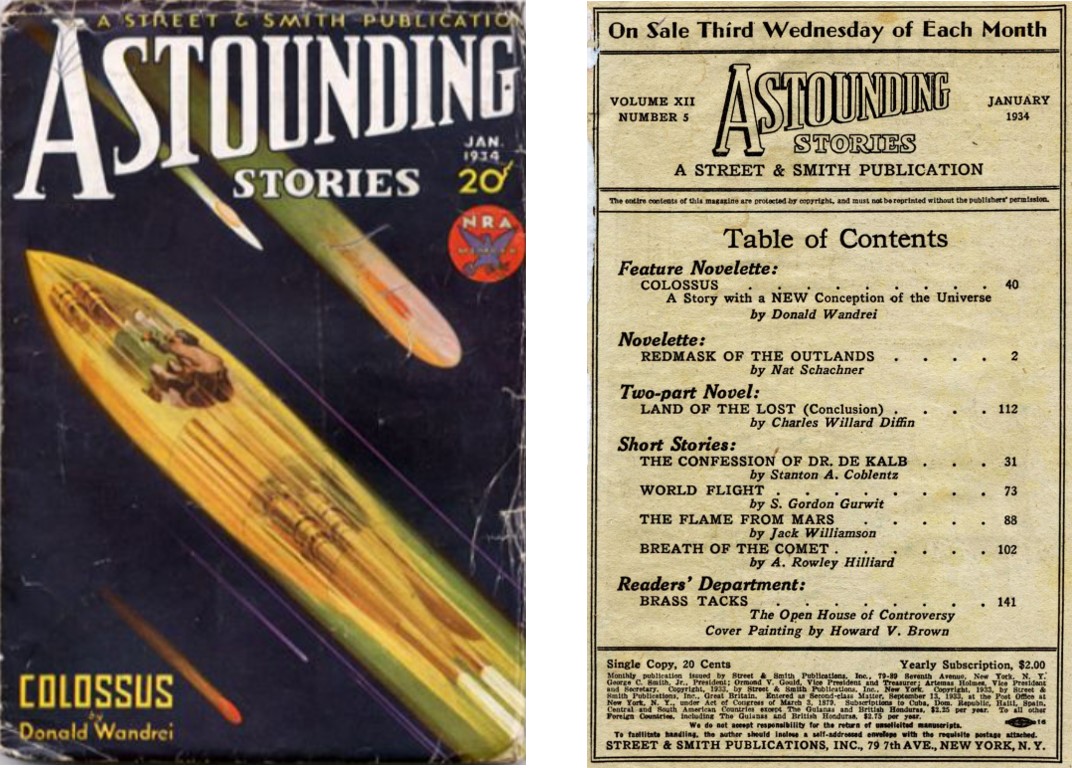
One of the nice things about reading these issues of Astounding Stories from the mid-'30's is the sense of time travel. There is a slight other-worldliness about them and the stories they contain. I know Isaac Asimov read these in his youth. He didn't have the money to have bought them, but the candy stores his family owned carried newspapers and magazines, and we know Astounding was his favourite - he never missed an issue. Nat Schachner is known to have been a favourite author of the young Asimov. He turned 14 in January 1934, and I can imagine him in his room above the candy store at 1312 Decatur Street, Brooklyn, reading these very same issues. The site as it looks today (currently boarded up), is shown.

Redmask of the Outlands - Nat Schachner
A much more straightforward adventure then Schachner's story in the preceding month, this novelette is very much of its time. In the year 5500 AD, most people live is isolated protected city states, each ruled by oligarchs. Each city is impervious and hermetically sealed, and treats all workers as second class citizens. On the outside, in the natural landscape live outlanders, who's leader is the mysterious 'Redmask', who wears a bowl-shaped red 'penetron' helmet. City factions clash when it seems Redmask has kidnapped two oligarchs. It's all rather daft, and the motivations of the different groups and the tidy ending don't seem to make a lot of sense. But it is fun.
The Confession of Dr De Kalb - Stanton A. Coblentz
An interesting short story - a young and optimistic natural scientist invents a general anaesthetic that wipes an individual's personality, allowing a new 'improved' personality to be installed while the patient is under the anaesthetic. In this way, the scientist imagines the greedy can be made frugal, the mean made well-meaning, and criminals be turned into model citizens. But this isn't the simple outcome. Most who take the treatment opt to become artistic or sporty, and the world gains vast numbers of poets and sportsmen at the expense of factory workers and farmers. The story explores some interesting ideas; is 'progress' necessarily good if doesn't proceed at a 'natural pace'? Is unfettered freedom for all in their pursuits what is best for the race, and is it what we all really want? In many ways, this should have been the 'Thought-Variant' story for the month.
Colossus - Donald Wandrei (Thought-variant feature story)
The second 'thought-variant' story published in Astounding Stories by Orlin Tremaine was a novelette that has become fairly well-known since it first saw press. Wandrei (see photo) wrote here the first story that considers that the universe we are in may be a tiny part of a succession of larger universes. A new idea at the time, Wandrei's hero jets off from Earth, leaving behind a terminal war and sets off to discover what is at the end of the universe. Science very much takes a back seat to spectacular notions in this tale. Despite referencing Einstein's contention that you can't travel faster than light, Wandrei's hero just does anyway, with the suggested consequence that as his speed increases, his ship gets larger and larger. Eventually, he gets to the 'end' and breaks through, to find he has left an atom, and is now a tiny man in the laboratory of giant aliens in their own universe. This is fun and enjoyable, but mostly from an historical perspective. Although proposed as a 'thought-variant' in which we should open our minds to amazing new ideas, it actually works better if you leave your mind at the door as you enter - far too much makes zero logical or common sense!
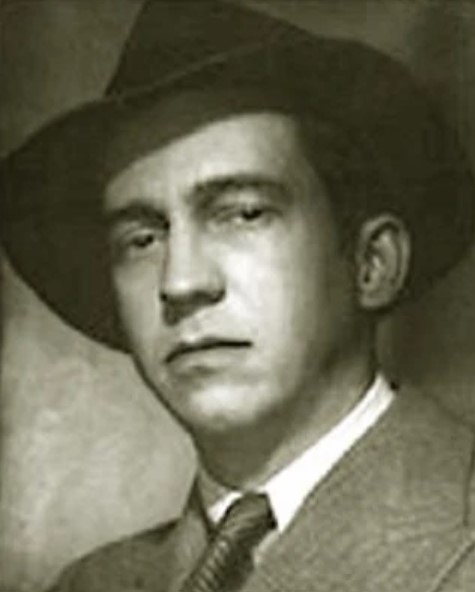
World Flight - S. Gordon Gurwit
This short story recounts the round-the-world test flight of a steam plane! Yep, for speed, convenience and efficiency, steam was still hot stuff in 1934 (you seen what I did there?). Unfortunately, our two heroes in their plane come into difficulties in the Himalayan Mountains and they have to put it down near a mysterious station. Here, they discover a giant spider-like 'Thing' and hugely tall Tibetan humans with guns. They then meet a Doctor Fang, who is a bit like a cross between a Tibetan version of Ming the Merciless and Dr Frankenstein. It's silly fun, but written in a very readable, smooth style.
The Flame from Mars - Jack Williamson
It's generally a joy to read an old Jack Williamson story, as the December 1933 story, described above, will testify.
Land of the Lost - Charles Willard Diffin
Diffin's two-part serial story concluded this month, with much hyperbole and action - the story was reviewed in full in the Dec '33 issue reviews, above.
The 'Thought-Variant' Stories Published by F. Orlin Tremaine, 1933-1937
1933
Ancestral Voices - Nat Schachner (Dec 33)
1934
Colossus - Donald Wandrei (Jan 34)
Rebirth - Thomas Calvert McClary (Feb 34) - not explicitly stated; inferred in an editorial (see pic)
Born of the Sun - Jack Williamson (Mar 34)
He From Procyon - Nat Schachner (Apr 34)
The Brain of Light - John Russell Fearn (May 34)
Sidewise in Time - Murray Leinster (Jun 34)
Before Earth Came - John Russell Fearn (Jul 34)
The Skylark of Valeron - Edward E. Smith (Aug 34)
The Living Equation - Nat Schachner (Sep 34)
Inflexure - Clyde Crane Campbell (Oct 34)
The Mole Pirate - Murray Leinster (Nov 34)
The Mightiest Machine - John W. Campbell, Jr (Dec 34; 5-part serial)
1935
The Ultimate Metal - Nat Schachner (Feb 35)
The Einstein Express - J. George Frederick (Apr 35; 2-part serial)
Earth's Mausoleum - John Russell Fearn (May 35)
The Son of Old Faithful - Raymond Z. Gallun (Jul 35)
The Galactic Circle - Jack Williamson (Aug 35)
Islands of the Sun - Jack Williamson (Sep 35; 2-part serial)
1936
White Adventure - Warner van Lorne (Apr 36)
The Time Entity - Eando Binder (Oct 36)
1937
The Great Thought - K. Raymond (Mar 37)
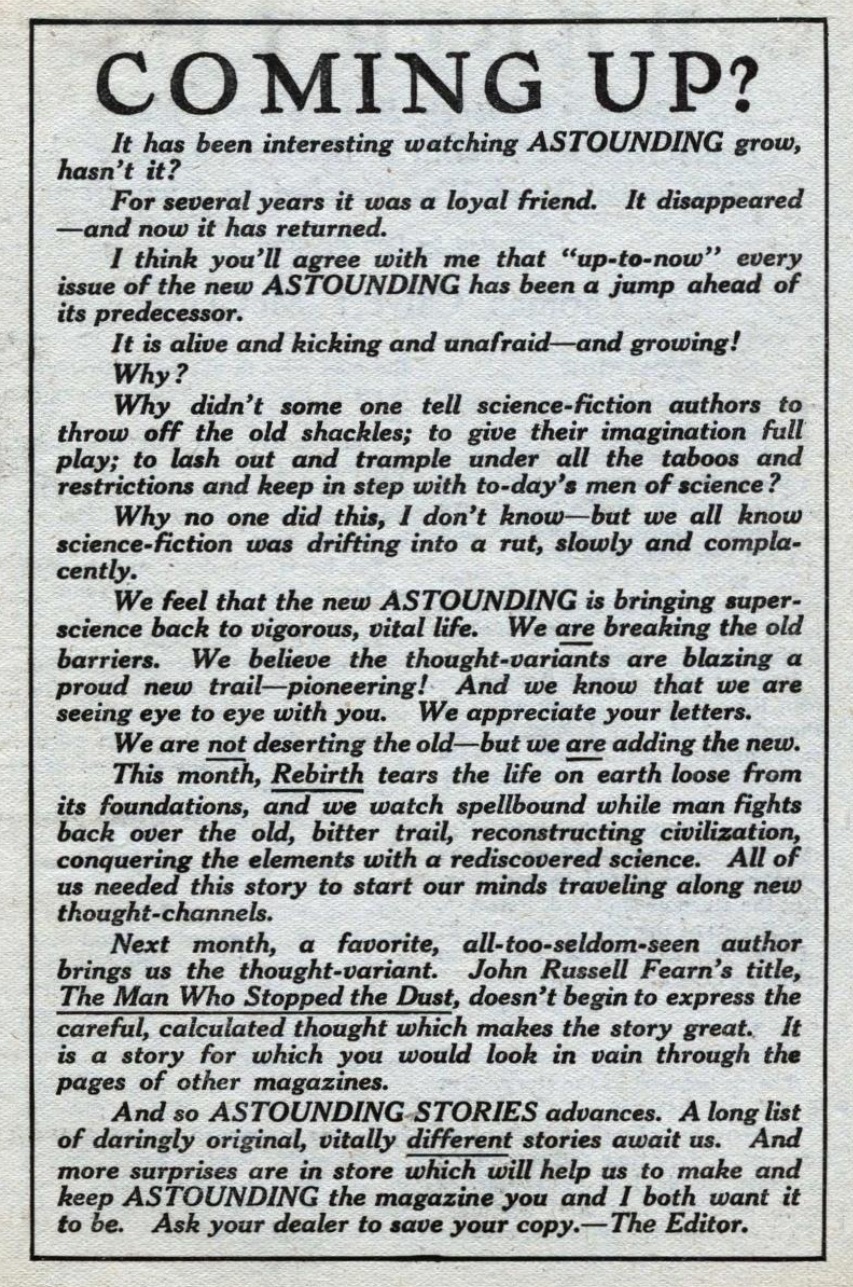
Reviews of Classic 'Thought Variant' Stories from Other Issues
Born of the Sun - Jack Williamson (Astounding March 1934)
The editorial article "Coming Up?", posted above, states that the Thought-Variant this month was going to be John Russell Fearn's The Man Who Stopped the Dust. However, when it came to it, that story was introduced as a second "feature story" and the "thought-variant" moniker was instead applied to Williamson's inventive novelette. Fearn's tale was re-classified as the "ultra-scientific study of the month". The impression one gets is from this is that Tremaine was pretty much making this up as he went along, flying by the seat of his pants. My suspicion is that he sorted through whatever he had to publish in any one month, and then picked one that he thought best fulfilled the brief to be a thought-variant and called it such. So, on to Williamson's story: this is a bit of a classic, as its covers a big idea that had not been considered before. The idea itself is very silly - that the moons and planets are actually eggs, "born of the sun", which are starting to hatch. The hatching starts with Pluto and works its way in toward the Earth. Once the moon hatches, visible to all, panic takes hold on Earth. Luckily, our hero in the story owns a steel mill and has been experimenting with methods of antigravity travel. He dedicates his factory to making a large spaceship to escape the coming cataclysm, with his dutiful fiancé on his arm. What makes matters worse, is that a Mongolian sect who predicted the hatchings are trying to stop him succeed in leaving the Earth. Gripping, if rather daft, dated stuff. Whether it really ticks the box for a 'thought variant', according to Tremaine's own idea I'm not sure. The first thought-variant (Schachner's Ancestral Voices) was much more thought-provoking and mature in many ways. This tale was included in Asimov's 1974 anthology Before the Golden Age, however, so it may be more familiar to many.
Sidewise in Time - Murray Leinster (Astounding June 1934)
Leinster's classic novella has been heavily anthologised over the years and was one of the very first SF stories concerned with parallel universes and alternate history (possibly it was the first). In 1935 strange occurrences, including a dramatic solar flare, presage a shift in the natural order of the fourth dimension, time. Rather than go back or forwards, pockets of the world are shuttle to and fro, 'sidewise' in time to alternative universes. A mathematics professor was the only person to predict and understand the phenomenon, and with a small group of his students, he goes out on horseback from his college, armed with revolvers, hoping to not only survive but find a suitable alternative reality to inhabit. The mathematician's ultimate goals (which I won't spoil) are a bit ludicrous, but perhaps we should gloss over that, because the story is inventive (for its time, very much so) and is told with verve and energy, making it quite engaging and enjoyable. Some of the little touches Leinster brings to the story are terrific. There's a moment where time shimmers again, resulting in the close presence of a world still locked in an ice-age. Leinster describes how it is only visible briefly, before condensation of the warm modern day air of a June day in the US condenses over the snowy landscape, hiding it from view - it's a great piece of hard SF imagery for such an old story. Like Born of the Sun, this tale presents a new idea in SF, but how much it makes one think in a new way, in the manner intended by Tremaine's 'thought-variant' project, I'm not sure. Recommended though as a classic in the genre.
